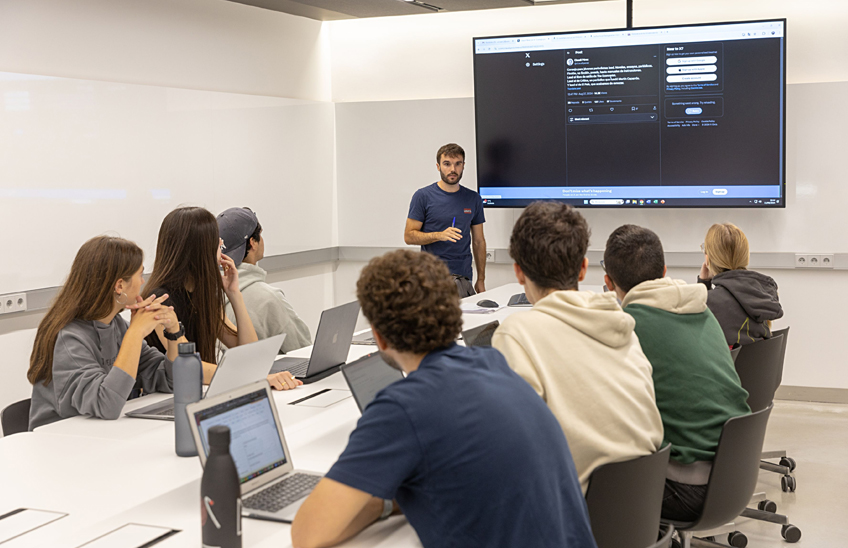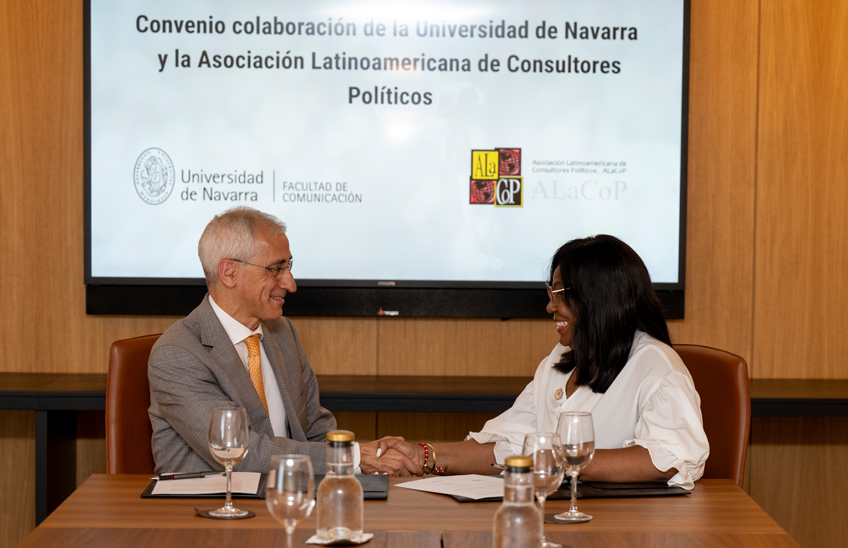The democratic role of the media: the era of fragmented and personalized news consumption
75% of Spaniards recognize that journalism contributes to democracy by informing, monitoring power or facilitating discussion.

PhotoManuelCastells/Roncesvalles Labiano, Aurken Sierra, María Fernanda Novoa and Alfonso Vara, DNR Spain researchers.
17 | 06 | 2025
In a context of news consumption that is complex and constantly adapting to digital habits: multi-screen, decentralized, fragmented and personalized, the democratic function of the media is evident in the consumption of information by citizens. This is one of the main conclusions of the Digital News Report Spain 2025prepared by researchers at the School of Communication of the University of Navarra.
According to the report, 75% of Spaniards recognize that journalism contributes to democracy, either by informing, facilitating discussion or monitoring power. In this framework, when asked about the origin of hoaxes, six out of ten respondents (57%) consider national politicians to be a major threat in relation to false and misleading information, ten points more than in the rest of the 47 countries where this study was carried out. Foreign politicians and influencers or internet personalities also appear among the most frequently mentioned sources of disinformation (45%). Faced with this threat, the media are the main tool for verifying unreliable content (34%), ahead of official sources (31%), search engines (24%) or content verifiers (23%).
However, this recognition of the media's public service coexists with distrust and a worrying information evasion that already reaches 37% of the population.
This deliberate rejection of current affairs, more frequent among younger groups and in extreme or indifferent political positions, is a consequence of distrust (35%), information overload (35%) and the negative impact of news on mood (34%).
The credibility of the local and regional press
In general, the majority of Spaniards, 40%, distrust the news, compared to 32% who trust it. However, credibility increases (38%) when asked about information that the respondent enquiry personally. In particular, local and regional newspapers are the media that inspire the greatest confidence among respondents: 51% usually trust them and almost half (47%) say they are very interested in local news. They are particularly interested in information on issues that affect them directly or help them to better understand their daily environment, such as events and accidents (52%), local Cultural Activities Office (45%) and public service issues (44%). On the other hand, news about municipal politics does not attract as much attention: only one third of respondents enquiry it (33%).
Television (54%) competes with social networks (46%) in terms of information consumption.
News consumption in Spain is increasingly digital, fragmented and decentralized. Television maintains its news leadership followed by social networks, although both have lost relevance. Meanwhile, print newspapers have seen their audience halved in six years (from 38% to 19%), while radio has fallen from 27% to 18%. Digital editions of traditional media have fallen from 44% to 25%. All these figures reveal a market characterized by the loss of weight of all news channels and a growing fragmentation of audiences, especially according to the level of interest in current affairs. People who are very interested prefer traditional sources such as television and digital newspapers, while those who show little or no interest mostly opt for other channels. Within the latter group, the majority prioritizes the consumption of content published by journalists or news media when accessing search engines (36%) or social networks (36%).
Social networks: platform diversity and generational rupture
Social networks enjoy enormous relevance in the news market in Spain. They are the second most popular source information enquiry 46%) and the main gateway for more than a quarter of citizens (28%). No platform clearly dominates the market anymore, which is concentrated around Facebook (24%), WhatsApp (23%), X 21%) and YouTube (19%). For their part, Instagram and TikTok are the big beneficiaries of a generational shift in information consumption: they are the favorite channels for information among the under-24s (28% and 25%, respectively).
At the same time that the informative centrality of social networks is growing, social demands on how to manage problematic content are increasing. These networks are also the most frequently mentioned as an important channel of disinformation: 73% of those surveyed think so. It is not surprising that the majority of Spaniards consider that the platforms themselves should eliminate false or harmful publications (51%), compared to 20% who support non-intervention.
1 in 3 Internet users say they have consumed video news in the last year
Video news in Spain has reached a stage of plenary session of the Executive Council development and is positioned as the most expanding format in the digital environment. According to the survey, 71% of respondents resorted to this format for information during the week prior to the study. This high level of adoption is supported by a wide availability of audiovisual platforms. YouTube, Facebook and Instagram each capture around 23% of users, while websites and media apps account for 21% of the audience. These figures vary with age. Among those under 35, TikTok is the leader (34% weekly usage), followed by Instagram and X 29%). In contrast, those over 65 prefer Facebook and YouTube (30%), along with WhatsApp (24%) and traditional websites (24%).
48% of Spaniards feel uncomfortable with AI-generated news under journalistic supervision
Spain is one of the countries with the lowest level of rejection of news generated by artificial intelligence (AI) under journalistic supervision and one of the most cautious when it comes to accepting it. The average level of comfort with this subject of automated news in Spain is 2.5 out of 5 points, higher than the average of the other countries analyzed (2.4) and above other countries in the region, such as the United Kingdom (2.0), France and Germany (2.4). However, its use raises concerns about quality, veracity or the loss of human judgment. In particular, 79% of those who distrust automated news monitored by a journalist sample a high Degree concern about hoaxes. Everything seems to indicate that there is a relationship between the distrust of AI and the fear that automated content favors the generation and dissemination of misinformation or errors.
For researchers at the University of Navarra, the public seems to demand editorial guarantees, transparency in the use of these technologies and human supervision to maintain control over news values. It is accepted that AI can help journalists, but it is feared that its application may replace professional judgment or degrade the quality of content.
66% of citizens consume personalized information tailored to their interests
66% of citizens receive news tailored to their interests, either consciously (22%) or automatically through algorithms (44%). Respondents' attitude towards this personalization is ambivalent. Although many value its usefulness in terms of receiving content according to their interests (52%) and managing information overload (47%), there is widespread concern about the possible negative effects. Sixty-two percent fear that personalization may cause them to miss important news, and 54% believe that it may reinforce partial or biased views of the world.
The journalistic brand is still relevant for users who are more interested and confident in the news, but it has lost weight as a portal for direct entrance to current affairs for a large part of the audience, which prefers to access through networks, search engines, aggregators, newsletters or notifications (69%). According to the authors of the study, the challenge for the media is twofold: to optimize their visibility in increasingly automated environments and to strengthen their own distribution channels -webs, apps, newsletters, notifications- to maintain a direct relationship with their audiences. This is the only way to avoid complete dependence on third parties for their content to reach readers.
The survey Digital News Report and the report Digital News Report Spain
The authors of report Digital News Report Spain 2025 and responsible for the interpretation of these data are researchers from the School of Communication of the University of Navarra, sponsor and academic partner since the 2014 edition. Digital News Report is a project of the Reuters Institute for the Study of Journalism at the University of Oxford, based on a survey conducted by YouGov covering 48 markets.
The survey is based on an online panel with a sample of more than two thousand people (N = 2014) in Spain, representative of the adult population connected to the Internet, based on various demographic, socioeconomic and territorial factors. The work was carried out by YouGov through an online survey conducted in January 2025.
report Digital News Report Spain 2025, with dozens of graphics, is available in open access for enquiry and attribution. It was commissioned by the Reuters Institute for the Study of Journalism at the University of Oxford and prepared by researchers at the School of Communication at the University of Navarra.
This project is part of theSociety and Digital Communication area of the University of Navarra's Strategy 2025.
This publication is part of the research and development project Digital native media in Spain: typologies, audiences, trust building and keys to journalistic sustainability - DIGINATIVEMEDIA 2 - reference letter PID2021-122534OB-C22, financed by Ministerio de Ciencia e Innovación/Agencia Estatal de research /10.13039/501100011033/ and European Regional development Fund "Una manera de hacer Europa".
The research is also part of the IBERIFIER Plus - Iberian Digital average Observatory project , which has received funding from the European Commission under the call DIGITAL-2023-DEPLOY-04, European Digital average observatory (EDMO) - National and multinational hubs, with reference letter IBERIFIER Plus - 101158511.



